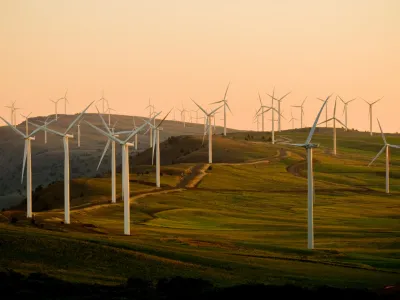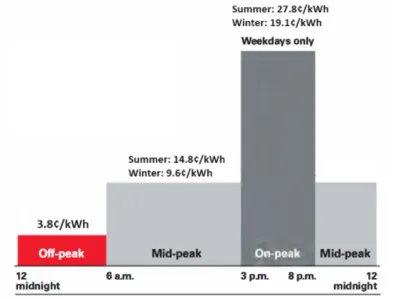CUB requests improvements to Xcel’s proposed time-of-use rate

In December 2023, Xcel Energy filed a petition to implement a default Time-of-Use (TOU) rate for all residential customers, with the option to opt-out. CUB and other parties filed initial comments responding to Xcel’s proposal last week. CUB generally supports TOU rates, as they could provide many potential benefits to customers and the electric grid. However, we do not believe that the rate Xcel proposed will be successful at achieving those ultimate goals. We also appreciate public concerns regarding such a big shift in the way we pay for electricity, and recognize that greater customer acceptance and understanding of the rate will be necessary for a successful rollout.
For these reasons, CUB has recommended Xcel's proposed TOU rate not be implemented until the utility makes several important improvements.
What are time-of-use rates?
TOU rates are a pricing structure that charges customers varying rates for electricity based on the time of day it is used. There is usually a “peak” period of several hours where the price of electricity is significantly more expensive than the standard rate, and an “off-peak” period where the price is significantly discounted. This rate structure primarily seeks to achieve three things:
TOU rates seek to reduce overall energy demand during peak hours
There are certain times of the day when customers tend to use more energy overall, called peak periods. During those times, the utility must provide greater amounts of electricity than usual to keep up with the demand. Because utilities always plan to have enough capacity to meet customer demand even during those peak periods, they often rely on additional sources of generation, called "peaker" plants, to help meet demand only during those high-use periods. High peaks are not only more expensive and require additional infrastructure investments to deliver the electricity, they also put immense strain on the electricity grid which can hinder reliability.
In a TOU rate, the price difference between peak- and off-peak rates is meant to encourage customers to shift their usage from high-use periods to other times of the day when electricity is cheaper to generate. If enough customers shift their electricity use, fewer "peaker" plants or other generation resources will be needed to meet demand. The utility can then defer, reduce, or avoid additional investments—saving customers those costs.
TOU rates seek to more closely align the actual cost of using electricity with customer use
Under a traditional flat-rate structure, customers using electricity during peak-demand times are paying less than the cost to generate and deliver that electricity, and customers using electricity during periods of low demand pay more than the actual cost. People who use less peak power than their neighbors end up paying more than their fair share. Moreover, some studies have shown that low-income households, in particular, tend to use relatively little on-peak electricity, meaning those customers are likely to be paying to subsidize the more expensive electric used by others during those peak hours.
TOU rates seek to address this imbalance by charging different amounts based on when electricity is used. Charging customers the actual cost of the electricity they use is a fairer and more equitable pricing structure. Importantly, TOU rates are designed to be revenue neutral, meaning they are calculated so that the utility does not generate any more profit than it would under the standard rate.
TOU rates seek to accelerate electric grid decarbonization by encouraging customers to use electricity when renewable energy is most abundant
Renewable energy like wind and solar are some of the cheapest generation options, have very low operating costs once built, and do not require the purchase of fuel to generate electricity. TOU rates incentivize customers to use electricity when renewable energy is most abundant. For example, wind energy is widely available during overnight off-peak hours, and the TOU rates lower electricity price at that time encourages people to shift their usage to those hours. Conversely, natural gas generation is typically used for peaker plants, which are some of the most expensive generation options. Peaker plants also tend to emit more air pollution than other gas generators so by reducing reliance on them during peak periods, utilities can also reduce the greenhouse gas emissions from those plants.
As people and businesses increasingly electrify processes that traditionally relied on fossil fuels, like heating and transportation, we expect to see overall increases in electric use. Shifting electricity consumption from peak hours helps ensure the grid can keep up with the growing electricity demand that will come with decarbonizing Minnesota’s economy.
Xcel’s TOU rate proposal
Recognizing their potential benefits, Xcel proposed a three-period TOU rate that, if approved, would be implemented after the Company completes its rollout of advanced metering infrastructure—sometime in 2025. Under the current proposal, customers would be automatically enrolled in the TOU rate but would have the ability to opt-out of the rate at any time and return back to the standard one-period residential rate.
The graphic to the right shows the structure of Xcel’s current proposal with three different billing periods:

- Mid-peak rates (6 a.m. to 3 p.m. and 8 p.m. to 12 a.m. on weekdays; 6 a.m. to 12 a.m. on weekends and holidays): 14.8 cents per kWh during the Summer, 9.6 cents per kWh during the winter
- On-peak rates (3 p.m. to 8 p.m. weekdays only): 27.8 cents per kWh during the Summer, 19.1 cents per kWh during the winter
- Off-peak rates (12 a.m. to 6 a.m.): 3.8 cents per kWh
The peak period would only apply to weekdays, and the base or “mid-peak” rate would extend to those hours on weekends and holidays. The peak and mid-peak rates also vary seasonally, with higher rates in summer (June to September) than non-summer months (October to May). The off-peak rate is the same throughout the year.
On-peak costs would be 7.3 times higher than off-peak in the summer, and 5 times higher in the winter. The summer mid-peak rate is slightly higher than the current standard one-period rate (13.07 cents/kWh), and the winter mid-peak rate is slightly cheaper.
CUB’s concerns and recommendations
While a successful TOU rate has the potential to achieve the critical goals described above, designing the right rate to influence customer behavior on a broad enough scale is a difficult task. Although CUB generally supports TOU rates, we have several concerns regarding Xcel’s current proposal. Below are some of the concerns we highlighted in our initial comments. CUB ultimately recommended the Commission defer approval of Xcel’s TOU rate and require the Company re-evaluate rate options.
Xcel’s rate is unlikely to reduce peak demand for electricity
The primary goal of TOU rates is to reduce customer demand during peak hours. However, prior to this proposal, Xcel conduced a two-year pilot program with an almost identical rate structure that did not result in any substantial peak demand reductions. Moreover, Xcel’s TOU rate has a comparatively high price difference between peak and off-peak hours compared to most TOU rates implemented in other states. If such a high price signal was insufficient to drive change in customer behavior during the pilot, CUB is concerned that this default rate will similarly provide underwhelming results.
CUB recommended the Commission require Xcel to reconsider a shorter peak-period and lower price differentials.
Large summer bill increases may be difficult for many households
While Xcel’s TOU rate is revenue neutral overall (i.e. it does not generate more or less revenue for the utility than the standard one-period rate would), individual customer's bills may vary considerably. Xcel predicts that the average customer’s summer bill will increase by 17.8 percent, and non-summer bills will decrease by 10.6 percent. Significant changes on month-to-month bills can be difficult for customers to adapt to and budget for, particularly in summertime when Energy Assistance is unavailable.
CUB recommended Xcel be directed to evaluate the possibility of reducing the variation in between summer and winter rates. Additionally, CUB suggested several steps the utility could take when implementing TOU rates, like rolling them out in winter months, to give customers time to familiarize themselves with how the rates work before entering the more expensive summer period.
Xcel’s peak period may be too long and make it difficult for households to shift their usage
Many Xcel customers have submitted comments to the PUC expressing concerns about their ability to shift energy use away from Xcel’s proposed 3:00 to 8:00 p.m. on-peak window, and the possibility that their bills could increase as a result. Certain customer segments may be more vulnerable to price volatility or may lack the ability to shift their energy use. For instance, individuals with health concerns or seniors at higher risk of heat-related illness might not be able to adjust summer air conditioning usage as much as other populations. Households with young children might also have less flexibility in when cooking, bathing, or doing laundry.
CUB recommended Xcel be required to re-evaluate the rate with a shorter peak period. CUB also recommended that Xcel evaluate how TOU rates would impact specific customer segments before implementing them on a default basis.
Xcel must have a thorough plan for consumer education and outreach
Customer education about TOU rates is a critical component of rate success. In order for the benefits of TOU rates to be realized, customers need to understand when and how to shift their energy usage. Customers should also be armed with the information needed to make informed decisions about whether they would like to remain on the TOU rate or opt-out, depending on which rate can help them see bill savings.
To ensure such outreach is effective, CUB recommended several measures Xcel should take, including providing customers with personalized rate comparisons. This would allow households to better understand how the cost of electricity changes under the TOU rate versus the standard flat rate.
A reduced electric space heating rate should be approved
Xcel’s petition also includes a proposal for a new electric space heating rate, which would allow customers who primarily heat their homes with electricity to pay substantially reduced rates in the winter. This rate option is intended to fairly account for the lower cost to provide electricity used for heating, as heat is generally needed during seasons when electricity demand is lower. The rate should also incentivize households to electrify their home heating needs and help decarbonization efforts.
CUB is supportive of Xcel’s proposed electric space heating rate and recommended that the Commission approve that rate, independently from the rest of Xcel’s TOU proposal.
Next Steps
CUB is excited about the potential benefits Time-of-Use rates could provide customers and what they could mean for decarbonizing Minnesota’s electricity grid. However, we recognize the complexity of TOU rates and the challenges faced by customers in adapting their energy usage patterns. We will work to ensure that any rate approved will actually achieve the aims it sets out to, without negatively impacting customers or energy affordability. CUB plans to continue working with Xcel and other advocates to develop a successful TOU rate that can help achieve the customer benefits outlined above.
Get Involved – Submit a Written Comment!
The PUC is always interested in hearing the voices of consumers on issues in ongoing dockets. If you would like to share your thoughts or opinion on this topic, including any personal stories about how this decision might affect you, we encourage you to submit a written comment.
Written comments can be submitted online or sent by email to consumer.puc@state.mn.us. All written comments should reference Docket No. 23-524 and should be filed before June 17, 2024 at 4:30pm. Please note that everything in your comment (whether submitted online or via email) will become part of the public record.